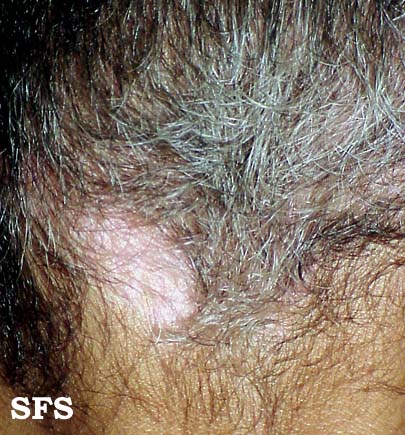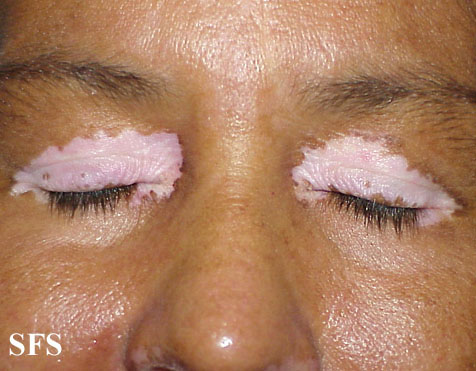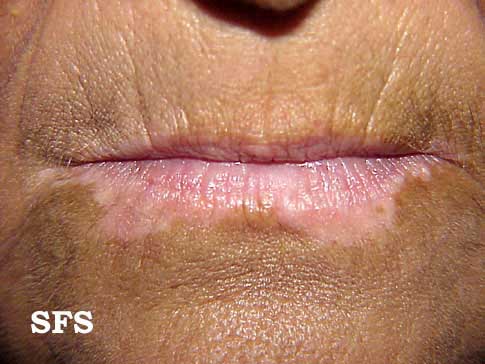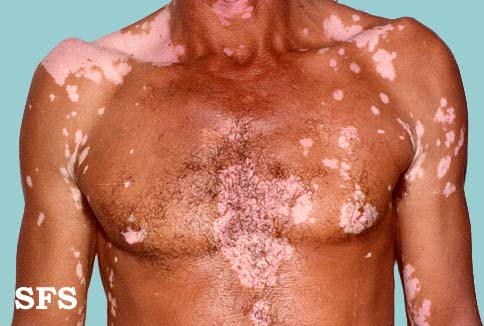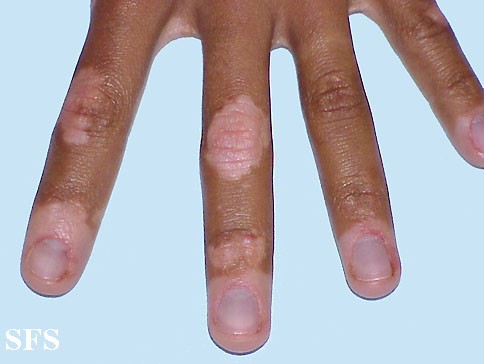Vitiligo (White Patchy Skin Disease) Causes, Symptoms, Pictures
What is vitiligo?
Vitiligo is a skin disease marked by the loss of normal pigmentation. These changes in pigmentation renders the skin lighter than normal (hypopigmented). Eventually there is total loss of pigmentation and white patches are present on the skin (depigmentation), hence the common term white skin disease. Despite these patches being prone to sunburn and therefore experiencing some burning and redness, there are usually no other symptoms present in vitiligo apart from the loss of normal pigmentation. Vitiligo is cause of great distress for persons suffering with this condition especially as new patches appear on various sites throughout the body and existing patches gradually increase in size. However, the disease has no long term complications apart from the psychological impact related to the aesthetic effects of the disease.
Causes of Vitiligo
The exact cause of vitiligo is unknown. Several possible mechanisms are believed to be responsible for the hypopigmentation but none of these theories have been conclusively proven to be responsible for vitiligo. It appears the condition is multifactorial meaning that an interplay of several factors are involved in the condition. Some of these factors are related to genetics, while others are possibly environmental.
Normal Skin Pigmentation
Skin pigmentation varies among different ethnic groups and even among individuals within each group. The pigmentation is determined by genetics. It arises with the amount of melanocytes and melanin deposited within the skin. Melanocytes are located at the innermost layer of the epidermis. It produces a pigment known as melanin which is deposited into the skin. The amount of pigment determines a person’s skin, hair and eye color. Melanin deposition in the skin can alter with sun exposure – greater exposure increases melanin production and deposition. However, it does not change a person’s natural pigmentation which will restore once the sun exposure is reduced. The melanin serves to protect the skin tissue against UV (ultraviolet) light.
Loss of Skin Color
In vitiligo, the loss of pigmentation occurs in patches which is associated with a loss of melanocytes (pigment-producing cells) in the affected area. This may be caused by one or more of the following mechanisms :
- The immune system attacks and destroys melanocytes. This autoimmune mechanism is the most popular theory to explain vitiligo. The gradual reduction in the number of melanocytes eventually renders the skin without any pigmentation in the affected area.
- Cellular defects within the melanocytes leads to its death as it is physiologically unable to continue functioning. Sometime programmed cellular death is triggered despite the cell being healthy and functioning.
- The build up of free radicals with normal cellular process is normally counteracted by antioxidants that are also produced by the cell. However, should these free radicals not be neutralized it can lead to a large degree of oxidative stress. This eventually causes destruction of the melanocyte.
- Nerve problems may somehow be related to vitiligo as loss of pigmentation has been noted in areas of nerve injury. It appears that certain chemicals secreted from nerve endings may influence normal pigmentation. In vitiligo though, the effects may not be directly on the melanocytes but rather nerve injury may alter immune activity in the area and allow for melanocyte destruction.
- Genetics may play a central role in vitiligo although it is not always clear how this may occur. It is possible that certain genes may be directly responsible for disturbing the melanin production, while other genes can affect the way melanocytes deal with oxidative stress or compromise the immune system’s ability not to attack melanocytes thereby leading to cell death.
- Repeated injury to the skin may also affect melanocytes and melanin production at specific areas. However, in most cases skin injury leads to darkening (hyperpigmentation).
Signs and Symptoms
Vitiligo present with hypopigmented skin patches without any other symptoms often seen with skin diseases like itching, dryness of the skin, scaling skin and swelling. In lighter skinned individuals, vitiligo is not always visible with the naked eye. The patches of skin quickly turns red with a burning sensation in direct sunlight and there may be some itching. These symptoms are related to sunburn which occurs much faster in the affected skin due to the lack of sufficient pigmentation. Although the parts of the skin without pigmentation should be more prone to conditions like skin cancer, recent scientific evidence suggests that vitiligo sufferers may have a greater degree of natural protection to skin cancer.
Vitiligo Skin
The distribution of vitiligo skin lesions can be divided into three patterns.
- Localized where hypopigmentation is isolated to very few areas of the body (focal) or on one side of the body (segmental).
- Generalized where vitiligo is present on most areas of the body as patches that may eventually expand to coalesce into much larger lesions.
- Universal where most of the skin on the body is affected. This should not be confused with albinism which is a congenital disorder affecting pigmentation throughout the body from birth.
Although the distribution can vary significantly, the typical lesions in vitiligo are fairly distinct.
- Round, oval and linear patches that are hypopigmented (white).
- Lesions that gradually enlarge over months and years or may sometimes resolve completely only to recur.
- First lesions more commonly seen on the face, forearms, hands and feet.
- Patches of white or gray hair.
The more common sites affected by vitiligo includes the face, elbows, hands and fingers, genitals, knees and shin.
Pictures
The vitiligo pictures below are from Dermatology Atlas Brazil courtesy of Samuel Freire da Silva, M.D.

